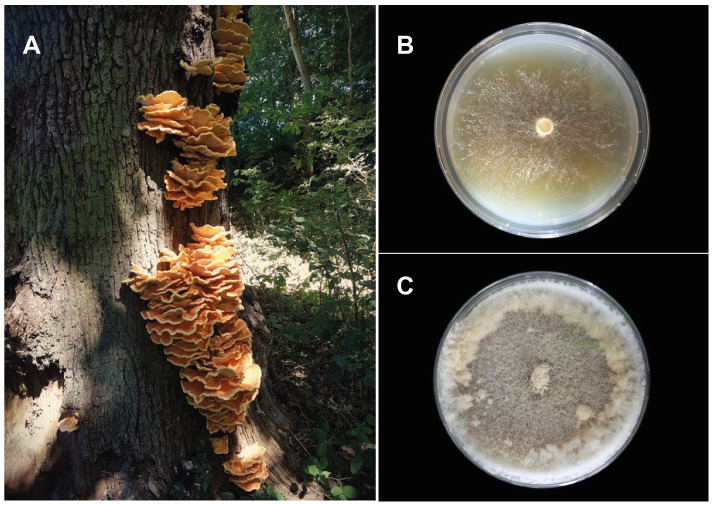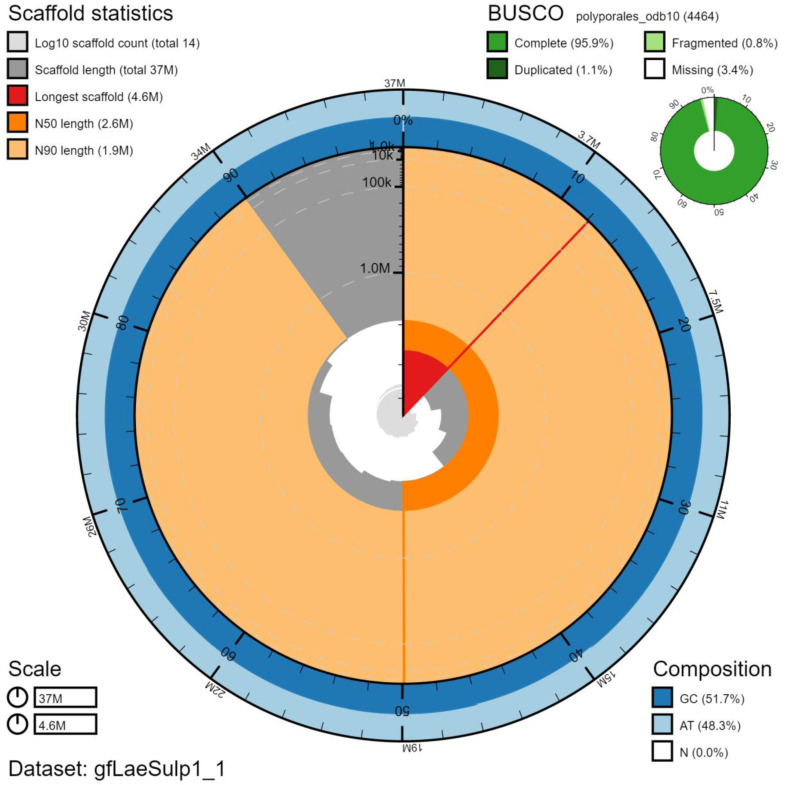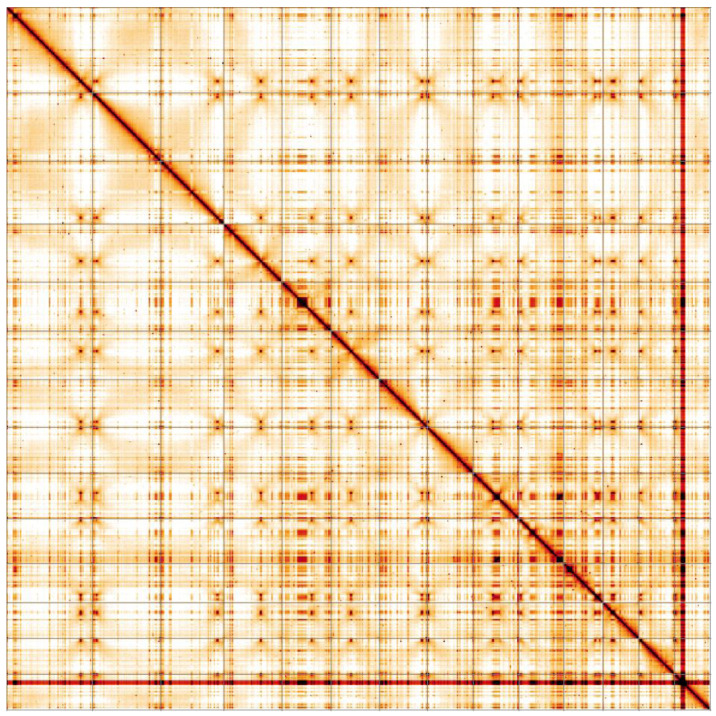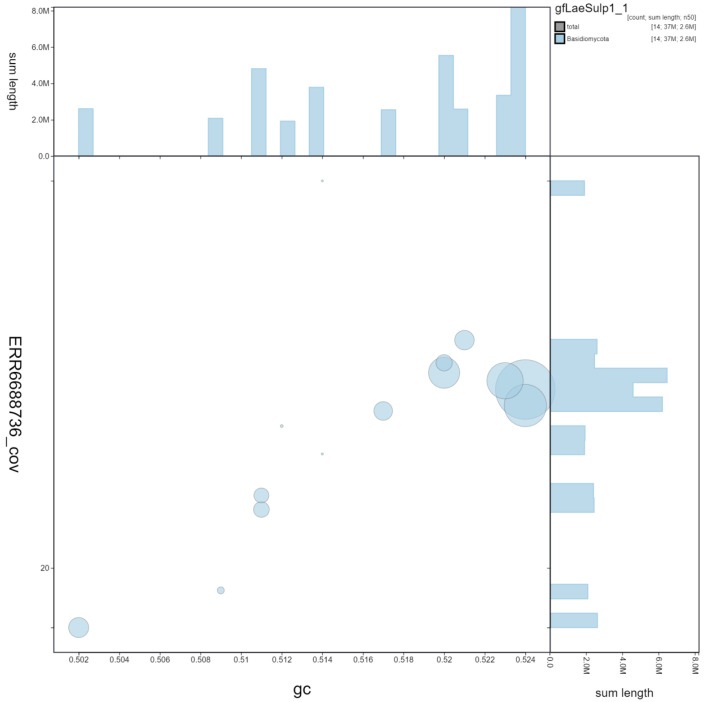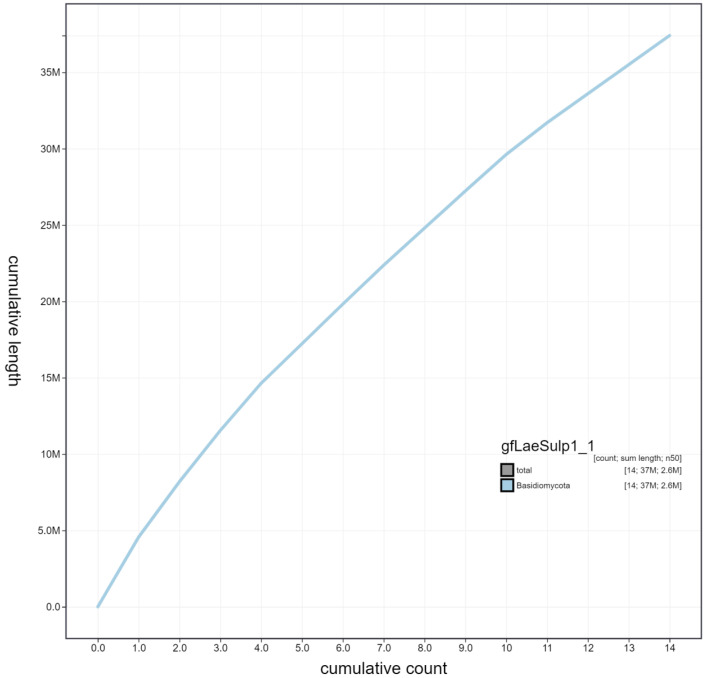Abstract
We present a genome assembly from an individual Laetiporus sulphureus (the chicken of the woods fungus; Basidiomycota; Agaricomycetes; Polyporales; Laetiporaceae). The genome sequence is 37.4 megabases in span. The complete assembly is scaffolded into 14 chromosomal pseudomolecules.
Keywords: Laetiporus sulphureus, chicken of the woods, genome sequence, chromosomal, Fungi
Species taxonomy
Eukaryota; Opisthokonta; Fungi; Dikarya; Basidiomycota; Agaricomycotina; Agaricomycetes; incertae sedis; Polyporales; Laetiporaceae; Laetiporus; Laetiporus sulphureus ((Bull.) Murrill, 1920) (NCBI:txid5630)
Background
Laetiporus sulphureus (chicken of the woods) is a poroid fungus that produces large, fleshy, orange to citric yellow, annual bracket-like sporocarps, with an undulating margin, which can grow up to 40 cm in size. A smooth, vivid yellow pore layer with 3–4 pores per millimetre can be observed in the underside. Sporocarps can occur individually or in large imbricate clusters. They have a dimitic hyphal structure and the generative hyphae lack clamps. Spores are ellipsoid to ovoid, smooth, hyaline, measuring 5–8 × 4–5 μm ( Ryvarden & Melo, 2017). In culture, the hyphae are hyaline, clamped and sparingly branched, with some aerial growth. They produce large, thick-walled, terminal chlamydospores and smaller thin-walled conidia. Aging cultures appear dull yellow or orange, with a granular texture due to asexual spore production.
This species can form dense, vertical, rubbery sheets of mycelium along radial lines in well colonised heartwood, which are a distinctive identification feature when sporocarps are not present.
Laetiporus sulphureus has a distribution that includes Europe as well as North and South America ( Song & Cui, 2017). Throughout Europe it is known to cause a brown-rot in the heartwood of a range of angiosperm trees, particularly Quercus, where it is a key engineer of hollowing, but it can also be found in species of Castanea, Fraxinus, Prunus, and Salix. It is also considered to occur on the gymnosperm Taxus baccata. In the UK, L . sulphureus is widespread and common wherever host trees are present.
Laetiporus sulphureus represents a group of cryptically diverse taxa that in recent years has undergone significant and ongoing revision ( Song et al., 2018). The genome produced for this collection has the potential to help us resolve the cryptic diversity of this genus in the UK and to greatly expand our understanding of how these essential wood recyclers operate and interact in their environment. This information may be critical to our ability to protect the associated organisms that rely on dead wood and tree hollow habitats.
Genome sequence report
The genome was sequenced from a single L. sulphureus specimen ( Figure 1) collected from Oldbury Court, Bristol, UK (latitude 51.4897, longitude -2.5253). A total of 106-fold coverage in Pacific Biosciences single-molecule HiFi long reads and 1853-fold coverage in 10X Genomics read clouds were generated. Primary assembly contigs were scaffolded with chromosome conformation Hi-C data. Manual assembly curation corrected 7 missing/misjoins and removed 3 haplotypic duplications, reducing the assembly size by 2.87%, the scaffold number by 36.36% and the scaffold N50 by 0.88%.
Figure 1. Images of the Laetiporus sulphureus specimen used for genome sequencing.
( A) Laetiporus sulphureus spore producing bodies from which the culture for this genome was isolated, growing on the trunk of Quercus robur at Oldbury Court, Bristol. ( B) An isolate of L. sulphureus at 10 days growth on 0.5% malt tannic acid agar. ( C) An isolate of L. sulphureus at 30 days growth on 2 % malt extract agar.
The final assembly has a total length of 37.4 Mb in 14 sequence scaffolds with a scaffold N50 of 2.6 Mb ( Table 1). Of the assembly sequence, 100% was assigned to 14 chromosomal-level scaffolds (numbered by sequence length) ( Figure 2– Figure 5; Table 2). The assembly has a BUSCO ( Manni et al., 2021) completeness of 95.9% (single, 94.8%, duplicated 1.1%) using the polyporales_odb10 reference set (n=4464). While not fully phased, the assembly deposited is of one haplotype. Contigs corresponding to the second haplotype have also been deposited.
Figure 2. Genome assembly of Laetiporus sulphureus, gfLaeSulp1.1: metrics.
The main plot is divided into 1,000 size-ordered bins around the circumference with each bin representing 0.1% of the 37,410,216 bp assembly. The distribution of chromosome lengths is shown in dark grey with the plot radius scaled to the longest chromosome present in the assembly (4,563,458 bp, shown in red). Orange and pale-orange arcs show the N50 and N90 chromosome lengths (2,582,225 and 1,895,436 bp), respectively. The pale grey spiral shows the cumulative chromosome count on a log scale with white scale lines showing successive orders of magnitude. The blue and pale-blue area around the outside of the plot shows the distribution of GC, AT and N percentages in the same bins as the inner plot. A summary of complete, fragmented, duplicated and missing BUSCO genes in the polyporales_odb10 set is shown in the top right. An interactive version of this figure is available at https://blobtoolkit.genomehubs.org/view/gfLaeSulp1_1/dataset/gfLaeSulp1_1/snail.
Figure 5. Genome assembly of Laetiporus sulphureus, gfLaeSulp1.1: Hi-C contact map.
Hi-C contact map of the gfLaeSulp1.2 assembly, visualised in HiGlass. Chromosomes are given in size order from left to right and top to bottom.
Table 1. Genome data for Laetiporus sulphureus, gfLaeSulp1.1.
| Project accession data | |
|---|---|
| Assembly identifier | gfLaeSulp1.1 |
| Species | Laetiporus sulphureus |
| Specimen | gfLaeSulp1 |
| NCBI taxonomy ID | 5630 |
| BioProject | PRJEB47319 |
| BioSample ID | SAMEA8562046 |
| Isolate information | Mycelium |
| Raw data accessions | |
| PacificBiosciences SEQUEL II | ERR6808041 |
| 10X Genomics Illumina | ERR6688736-ERR6688739 |
| Hi-C Illumina | ERR6688740 |
| Genome assembly | |
| Assembly accession | GCA_927399515.1 |
| Accession of alternate haplotype | GCA_927399535.1 |
| Span (Mb) | 37.4 |
| Number of contigs | 17 |
| Contig N50 length (Mb) | 2.6 |
| Number of scaffolds | 14 |
| Scaffold N50 length (Mb) | 2.6 |
| Longest scaffold (Mb) | 4.6 |
| BUSCO * genome score | C:95.9%[S:94.8%,D:1.1%],F:0.8%,M:3.4%,n:4464 |
*BUSCO scores based on the polyporales_odb10 BUSCO set using v5.1.2. C= complete [S= single copy, D=duplicated], F=fragmented, M=missing, n=number of orthologues in comparison. A full set of BUSCO scores is available at https://blobtoolkit.genomehubs.org/view/gfLaeSulp1_1/dataset/gfLaeSulp1_1/busco.
Figure 3. Genome assembly of Laetiporus sulphureus, gfLaeSulp1.1: GC coverage.
BlobToolKit GC-coverage plot. Scaffolds are coloured by phylum. Circles are sized in proportion to scaffold length. Histograms show the distribution of scaffold length sum along each axis. An interactive version of this figure is available at https://blobtoolkit.genomehubs.org/view/gfLaeSulp1_1/dataset/gfLaeSulp1_1/blob.
Figure 4. Genome assembly of Laetiporus sulphureus, gfLaeSulp1.1: cumulative sequence.
BlobToolKit cumulative sequence plot. The grey line shows cumulative length for all scaffolds. Coloured lines show cumulative lengths of scaffolds assigned to each phylum using the buscogenes taxrule. An interactive version of this figure is available at https://blobtoolkit.genomehubs.org/view/gfLaeSulp1_1/dataset/gfLaeSulp1_1/cumulative.
Table 2. Chromosomal pseudomolecules in the genome assembly of Laetiporus sulphureus, gfLaeSulp1.1.
| INSDC accession | Chromosome | Size (Mb) | GC% |
|---|---|---|---|
| OV656674.1 | 1 | 4.56 | 52.4 |
| OV656675.1 | 2 | 3.64 | 52.4 |
| OV656676.1 | 3 | 3.34 | 52.3 |
| OV656677.1 | 4 | 3.10 | 52.0 |
| OV656678.1 | 5 | 2.61 | 50.2 |
| OV656679.1 | 6 | 2.58 | 52.1 |
| OV656680.1 | 7 | 2.54 | 51.7 |
| OV656681.1 | 8 | 2.44 | 52.0 |
| OV656682.1 | 9 | 2.42 | 51.1 |
| OV656683.1 | 10 | 2.39 | 51.1 |
| OV656684.1 | 11 | 2.08 | 50.9 |
| OV656685.1 | 12 | 1.92 | 51.2 |
| OV656686.1 | 13 | 1.90 | 51.4 |
| OV656687.1 | 14 | 1.89 | 51.4 |
Methods
Sample acquisition and nucleic acid extraction
A L. sulphureus specimen (glLaeSulp1) was collected from Oldbury Court, Bristol, UK (latitude 51.4897, longitude -2.5253) by Richard Wright, Royal Botanic Gardens Kew, from a Quercus sp. trunk. The specimens were identified by the same individual and snap-frozen on dry ice.
DNA was extracted at the Tree of Life laboratory, Wellcome Sanger Institute. The gfLaeSulp1 sample was weighed and dissected on dry ice with tissue set aside for Hi-C sequencing. Mycelium tissue was cryogenically disrupted to a fine powder using a Covaris cryoPREP Automated Dry Pulveriser, receiving multiple impacts. Fragment size analysis of 0.01–0.5 ng of DNA was then performed using an Agilent FemtoPulse. High molecular weight (HMW) DNA was extracted using the Qiagen Plant MagAttract HMW DNA extraction kit. Low molecular weight DNA was removed from a 200-ng aliquot of extracted DNA using 0.8X AMpure XP purification kit prior to 10X Chromium sequencing; a minimum of 50 ng DNA was submitted for 10X sequencing. HMW DNA was sheared into an average fragment size between 12–20 kb in a Megaruptor 3 system with speed setting 30. Sheared DNA was purified by solid-phase reversible immobilisation using AMPure PB beads with a 1.8X ratio of beads to sample to remove the shorter fragments and concentrate the DNA sample. The concentration of the sheared and purified DNA was assessed using a Nanodrop spectrophotometer and Qubit Fluorometer and Qubit dsDNA High Sensitivity Assay kit. Fragment size distribution was evaluated by running the sample on the FemtoPulse system.
Sequencing
Pacific Biosciences HiFi circular consensus and 10X Genomics Chromium read cloud sequencing libraries were constructed according to the manufacturers’ instructions. Sequencing was performed by the Scientific Operations core at the Wellcome Sanger Institute on Pacific Biosciences SEQUEL II (HiFi) and Illumina NovaSeq 6000 (10X) instruments. Hi-C data were generated in the Tree of Life laboratory from mycelium tissue of gfLaeSulp1 using the Arima v2 kit and sequenced on a NovaSeq 6000 instrument.
Genome assembly
Assembly was carried out with Hifiasm ( Cheng et al., 2021). Haplotypic duplication was identified and removed with purge_dups ( Guan et al., 2020). One round of polishing was performed by aligning 10X Genomics read data to the assembly with longranger align, calling variants with freebayes ( Garrison & Marth, 2012). The assembly was then scaffolded with Hi-C data ( Rao et al., 2014) using SALSA2 ( Ghurye et al., 2019). The assembly was checked for contamination and corrected using the gEVAL system ( Chow et al., 2016) as described previously ( Howe et al., 2021). Manual curation was performed using gEVAL, HiGlass ( Kerpedjiev et al., 2018) and Pretext. The mitochondrial genome was assembled using MitoHiFi ( Uliano-Silva et al., 2021), which performed annotation using MitoFinder ( Allio et al., 2020). The genome was analysed and BUSCO scores generated within the BlobToolKit environment ( Challis et al., 2020). Table 3 contains a list of all software tool versions used, where appropriate.
Table 3. Software tools used.
| Software tool | Version | Source |
|---|---|---|
| Hifiasm | 0.15.3 | Cheng et al., 2021 |
| purge_dups | 1.2.3 | Guan et al., 2020 |
| SALSA2 | 2.2 | Ghurye et al., 2019 |
| longranger align | 2.2.2 | https://support.10xgenomics.com/genome-exome/software/pipelines/latest/advanced/other-pipelines |
| freebayes | 1.3.1-17-gaa2ace8 | Garrison & Marth, 2012 |
| MitoHiFi | 2.0 | Uliano-Silva et al., 2021 |
| gEVAL | N/A | Chow et al., 2016 |
| PretextView | 0.2.x | https://github.com/wtsi-hpag/PretextView |
| HiGlass | 1.11.6 | Kerpedjiev et al., 2018 |
| BlobToolKit | 2.6.4 | Challis et al., 2020 |
Data availability
European Nucleotide Archive: Laetiporus sulphureus (chicken of the woods). Accession number PRJEB47319; https://identifiers.org/ena.embl/PRJEB47319.
The genome sequence is released openly for reuse. The L. sulphureus genome sequencing initiative is part of the Darwin Tree of Life (DToL) project. All raw sequence data and the assembly have been deposited in INSDC databases. The genome will be annotated and presented through the Ensembl pipeline at the European Bioinformatics Institute. Raw data and assembly accession identifiers are reported in Table 1.
Funding Statement
This work was supported by Wellcome through core funding to the Wellcome Sanger Institute (206194) and the Darwin Tree of Life Discretionary Award (218328).
The funders had no role in study design, data collection and analysis, decision to publish, or preparation of the manuscript.
[version 1; peer review: 2 approved]
Author information
Members of the Royal Botanic Gardens Kew Genome Acquisition Lab are listed here: https://doi.org./10.5281/zenodo.6283448.
Members of the Darwin Tree of Life Barcoding collective are listed here: https://doi.org/10.5281/zenodo.5744972.
Members of the Wellcome Sanger Institute Tree of Life programme are listed here: https://doi.org/10.5281/zenodo.6125027.
Members of Wellcome Sanger Institute Scientific Operations: DNA Pipelines collective are listed here: https://doi.org/10.5281/zenodo.5746904.
Members of the Tree of Life Core Informatics collective are listed here: https://doi.org/10.5281/zenodo.6125046.
Members of the Darwin Tree of Life Consortium are listed here: https://doi.org/10.5281/zenodo.5638618.
References
- Allio R, Schomaker-Bastos A, Romiguier J, et al. : MitoFinder: Efficient Automated Large-Scale Extraction of Mitogenomic Data in Target Enrichment Phylogenomics. Mol Ecol Resour. 2020;20(4):892–905. 10.1111/1755-0998.13160 [DOI] [PMC free article] [PubMed] [Google Scholar]
- Challis R, Richards E, Rajan J, et al. : BlobToolKit - Interactive Quality Assessment of Genome Assemblies. G3 (Bethesda). 2020;10(4):1361–74. 10.1534/g3.119.400908 [DOI] [PMC free article] [PubMed] [Google Scholar]
- Cheng H, Concepcion GT, Feng X, et al. : Haplotype-Resolved de Novo Assembly Using Phased Assembly Graphs with Hifiasm. Nat Methods. 2021;18(2):170–75. 10.1038/s41592-020-01056-5 [DOI] [PMC free article] [PubMed] [Google Scholar]
- Chow W, Brugger K, Caccamo M, et al. : gEVAL - a web-based browser for evaluating genome assemblies. Bioinformatics. 2016;32(16):2508–10. 10.1093/bioinformatics/btw159 [DOI] [PMC free article] [PubMed] [Google Scholar]
- Garrison E, Marth G: Haplotype-Based Variant Detection from Short-Read Sequencing.arXiv: 1207.3907.2012. Reference Source [Google Scholar]
- Ghurye J, Rhie A, Walenz BP, et al. : Integrating Hi-C Links with Assembly Graphs for Chromosome-Scale Assembly. PLoS Comput Biol. 2019;15(8):e1007273. 10.1371/journal.pcbi.1007273 [DOI] [PMC free article] [PubMed] [Google Scholar]
- Guan D, McCarthy SA, Wood J, et al. : Identifying and Removing Haplotypic Duplication in Primary Genome Assemblies. Bioinformatics. 2020;36(9):2896–98. 10.1093/bioinformatics/btaa025 [DOI] [PMC free article] [PubMed] [Google Scholar]
- Howe K, Chow W, Collins J, et al. : Significantly Improving the Quality of Genome Assemblies through Curation. GigaScience. 2021;10(1):giaa153. 10.1093/gigascience/giaa153 [DOI] [PMC free article] [PubMed] [Google Scholar]
- Kerpedjiev P, Abdennur N, Lekschas F, et al. : HiGlass: Web-Based Visual Exploration and Analysis of Genome Interaction Maps. Genome Biol. 2018;19(1):125. 10.1186/s13059-018-1486-1 [DOI] [PMC free article] [PubMed] [Google Scholar]
- Manni M, Berkeley MR, Seppey M, et al. : BUSCO Update: Novel and Streamlined Workflows along with Broader and Deeper Phylogenetic Coverage for Scoring of Eukaryotic, Prokaryotic, and Viral Genomes. Mol Biol Evol. 2021;38(10):4647–54. 10.1093/molbev/msab199 [DOI] [PMC free article] [PubMed] [Google Scholar]
- Rao SS, Huntley MH, Durand NC, et al. : A 3D Map of the Human Genome at Kilobase Resolution Reveals Principles of Chromatin Looping. Cell. 2014;159(7):1665–80. 10.1016/j.cell.2014.11.021 [DOI] [PMC free article] [PubMed] [Google Scholar]
- Ryvarden L, Melo I: Poroid Fungi of Europe.Fungiflora,2017. Reference Source [Google Scholar]
- Song J, Cui BK: Phylogeny, Divergence Time and Historical Biogeography of Laetiporus (Basidiomycota, Polyporales). BMC Evol Biol. 2017;17(1):102. 10.1186/s12862-017-0948-5 [DOI] [PMC free article] [PubMed] [Google Scholar]
- Song J, Sun YF, Ji X, et al. : Phylogeny and Taxonomy of Laetiporus ( Basidiomycota, Polyporales) with Descriptions of Two New Species from Western China. MycoKeys. 2018; (37):57–71. 10.3897/mycokeys.37.26016 [DOI] [PMC free article] [PubMed] [Google Scholar]
- Uliano-Silva M, Nunes JGF, Krasheninnikova K, et al. : marcelauliano/MitoHiFi: mitohifi_v2.0.2021. 10.5281/zenodo.5205678 [DOI] [Google Scholar]



